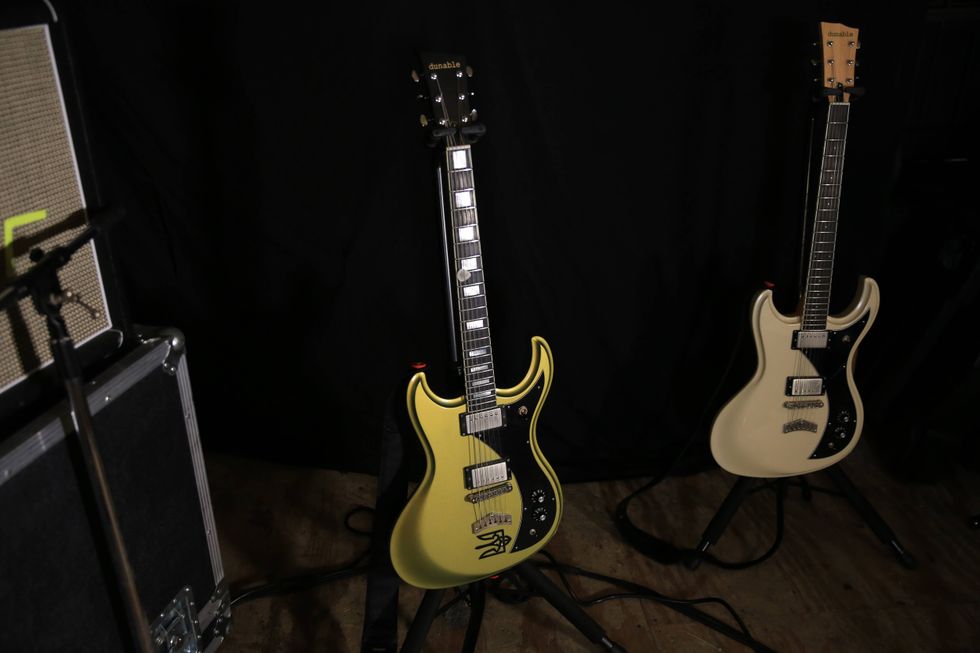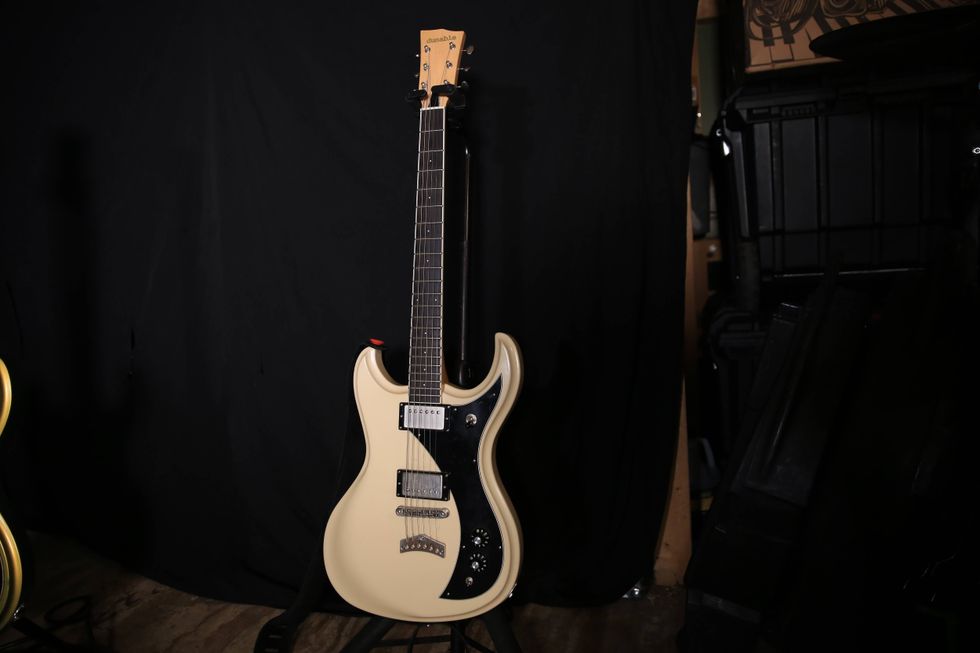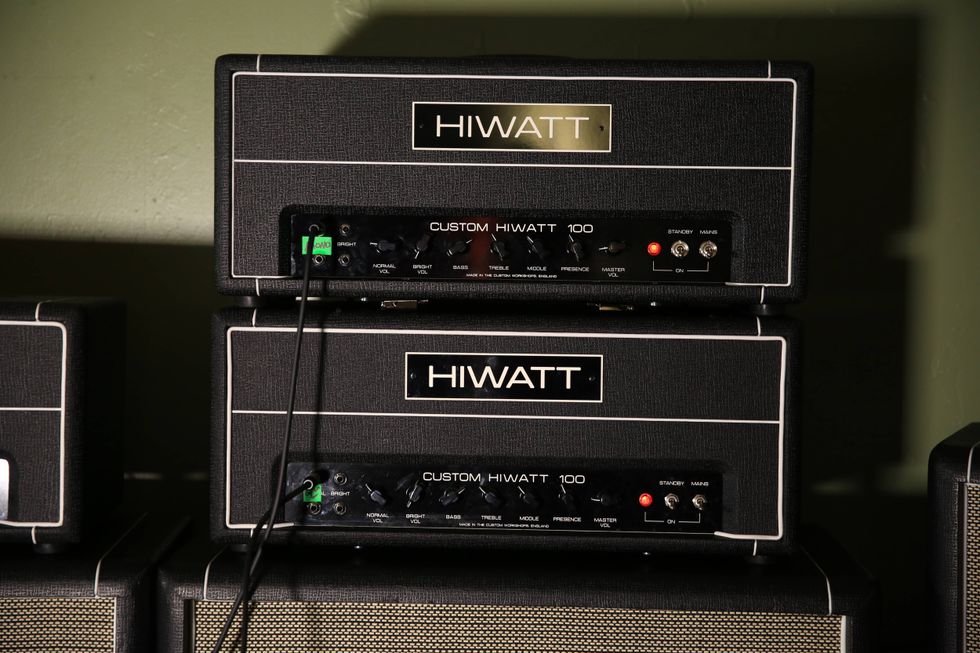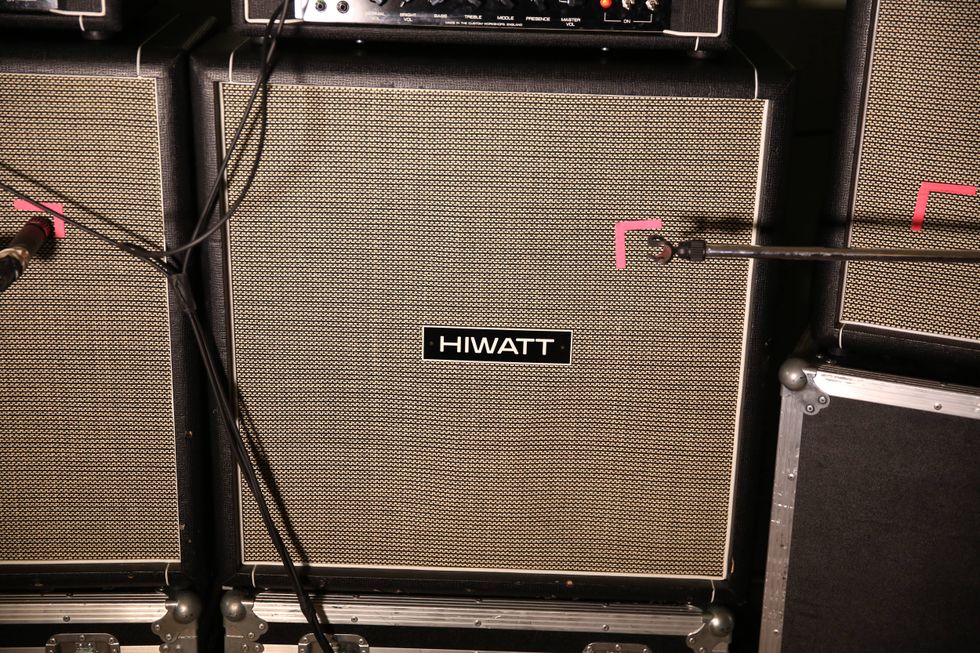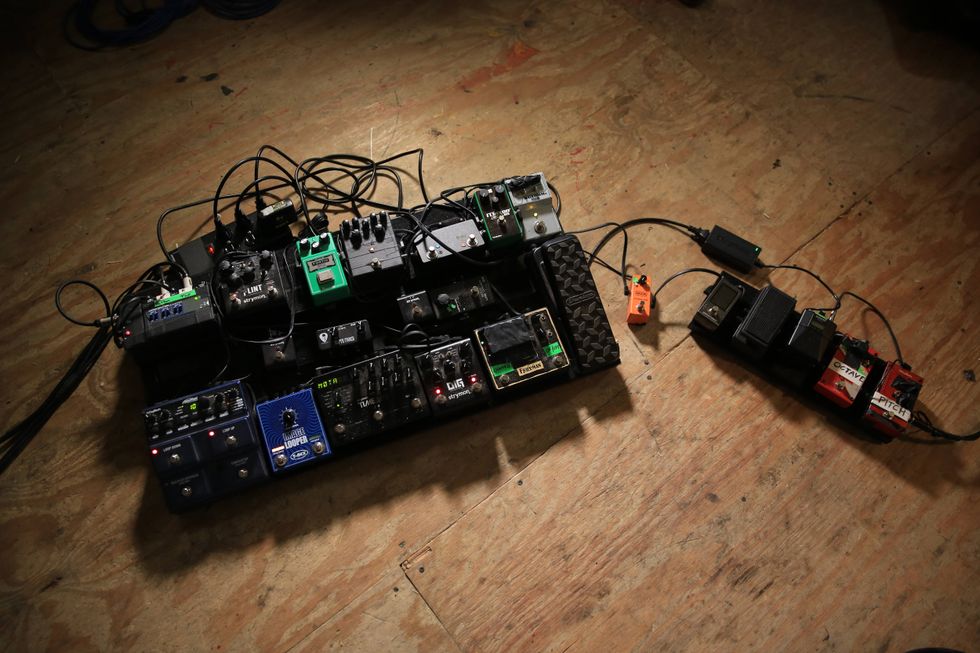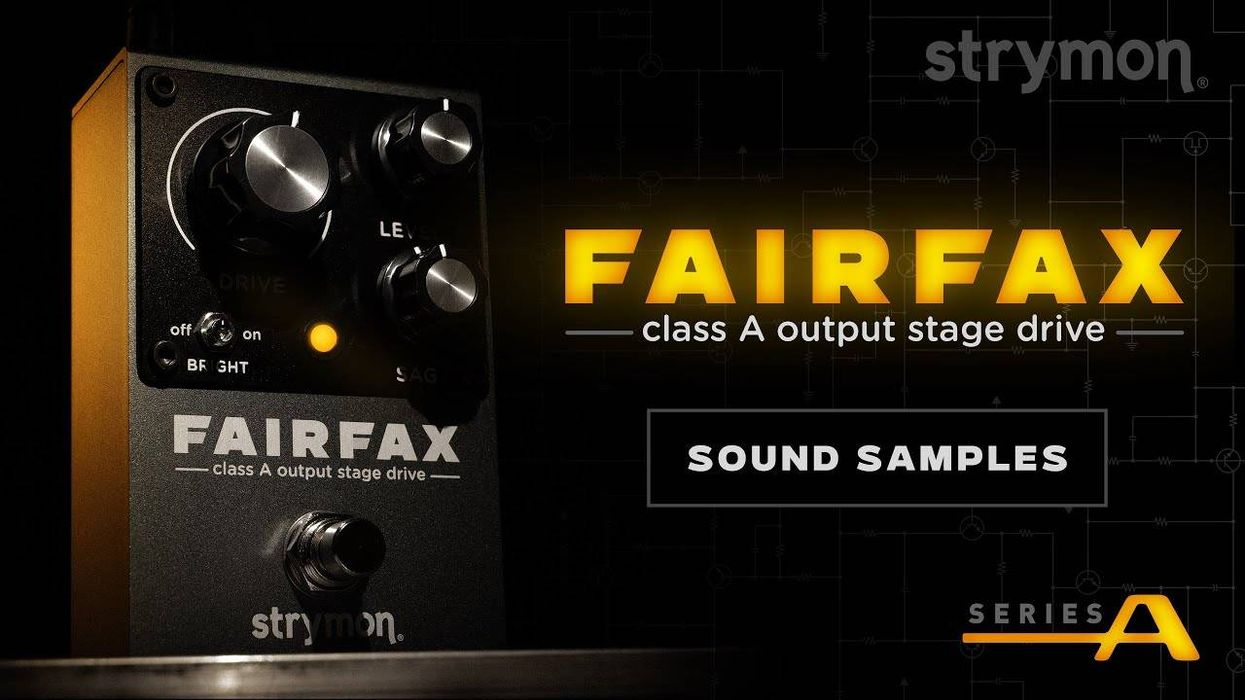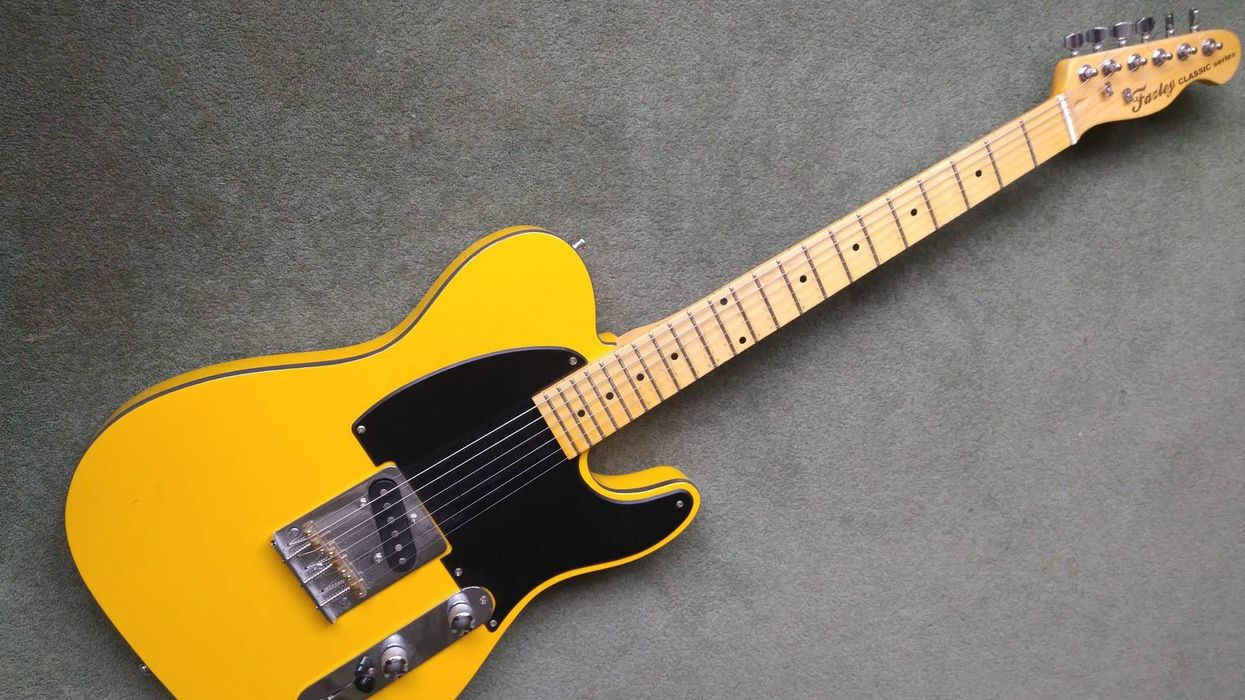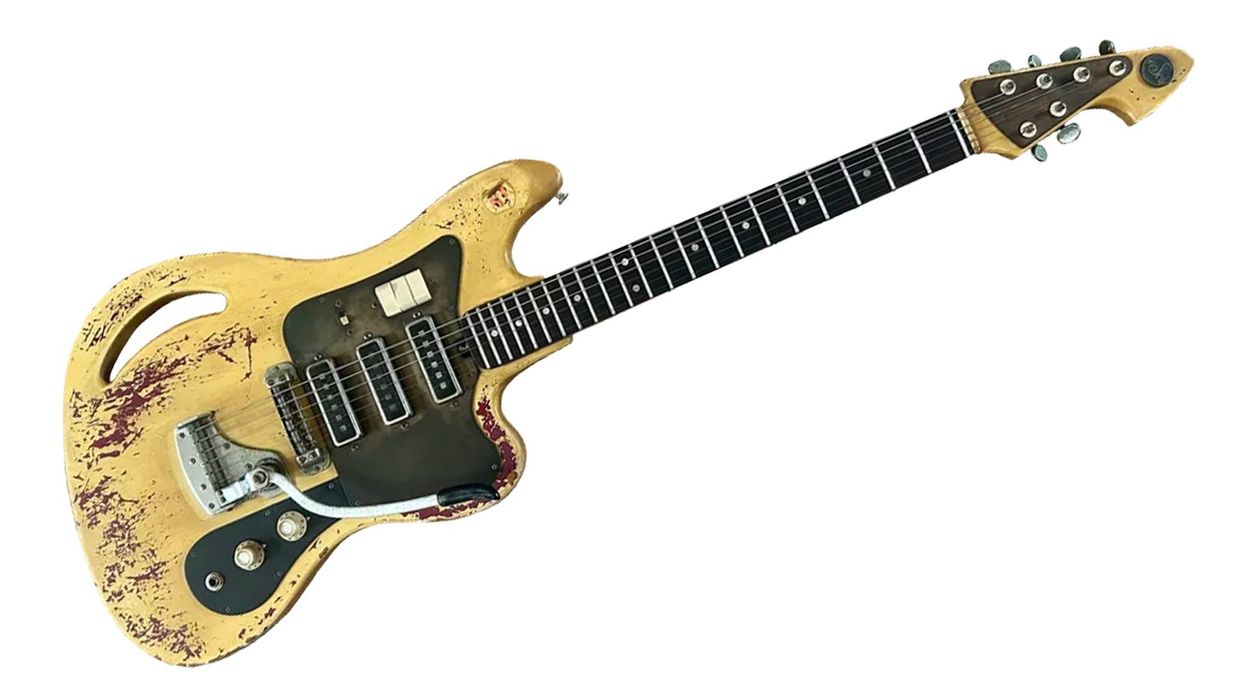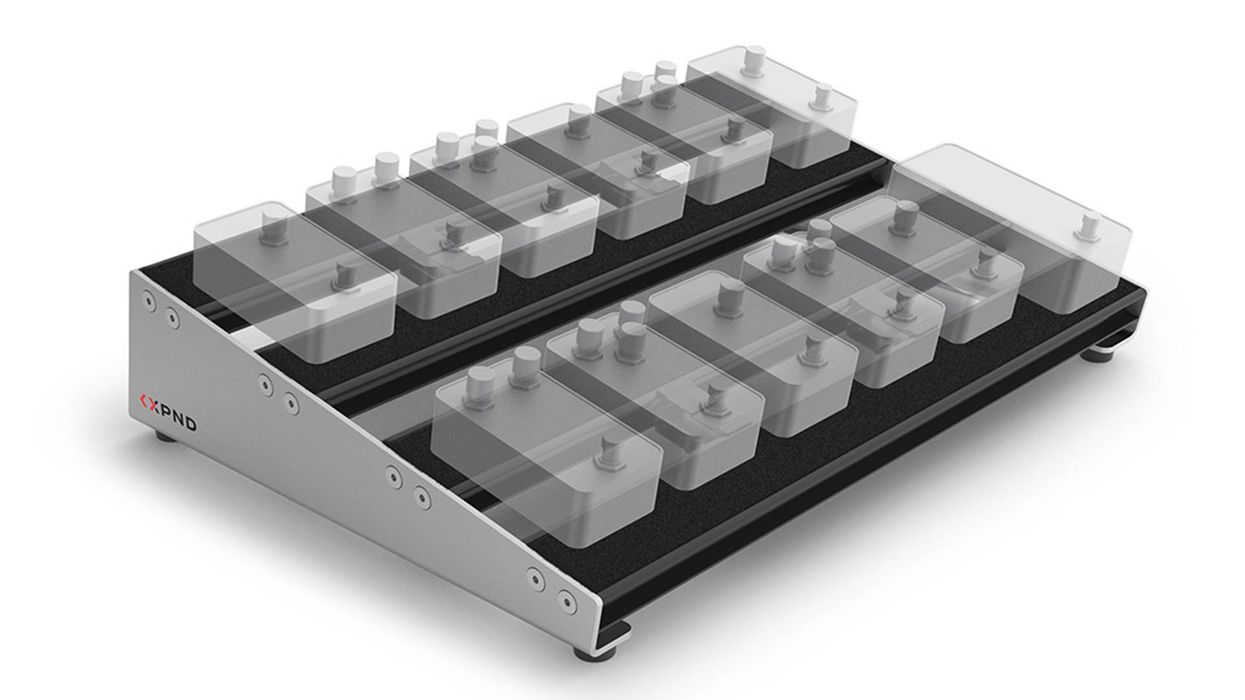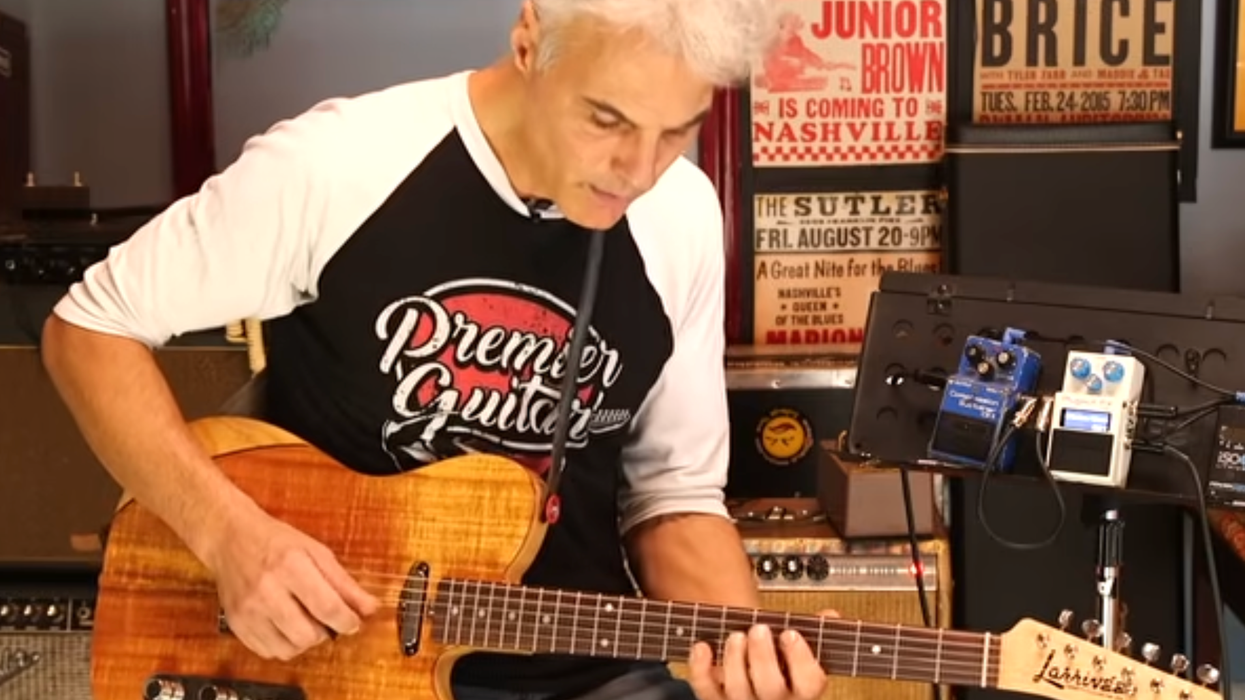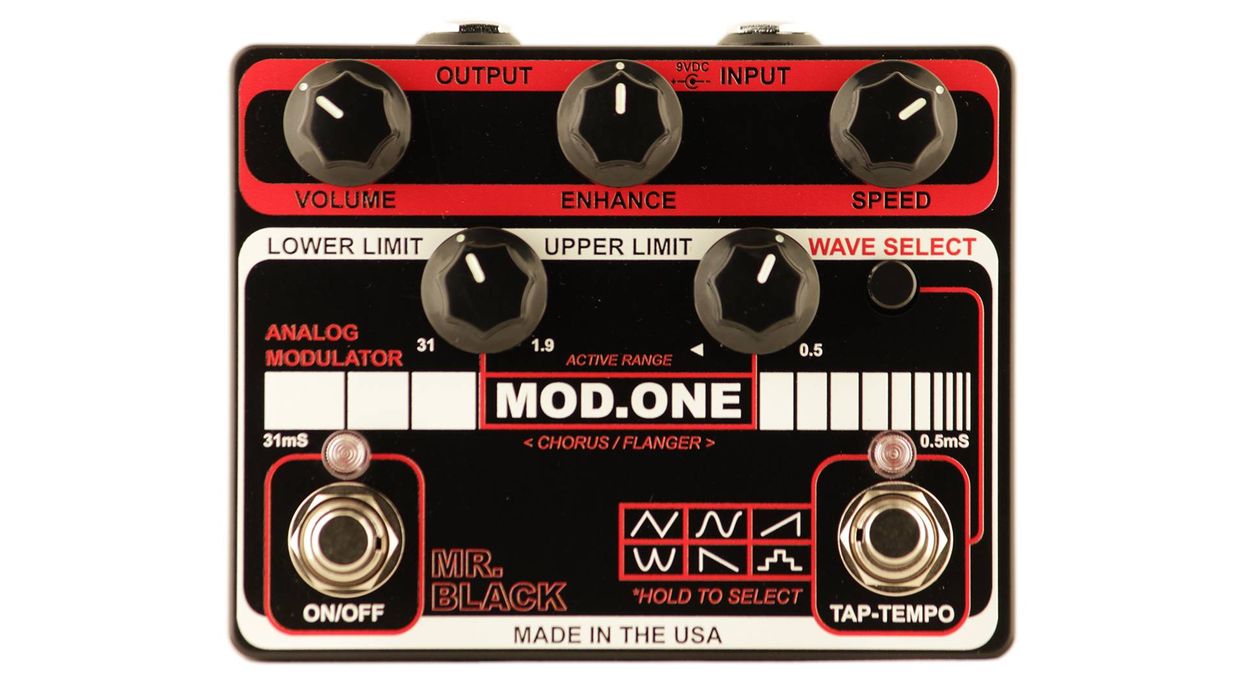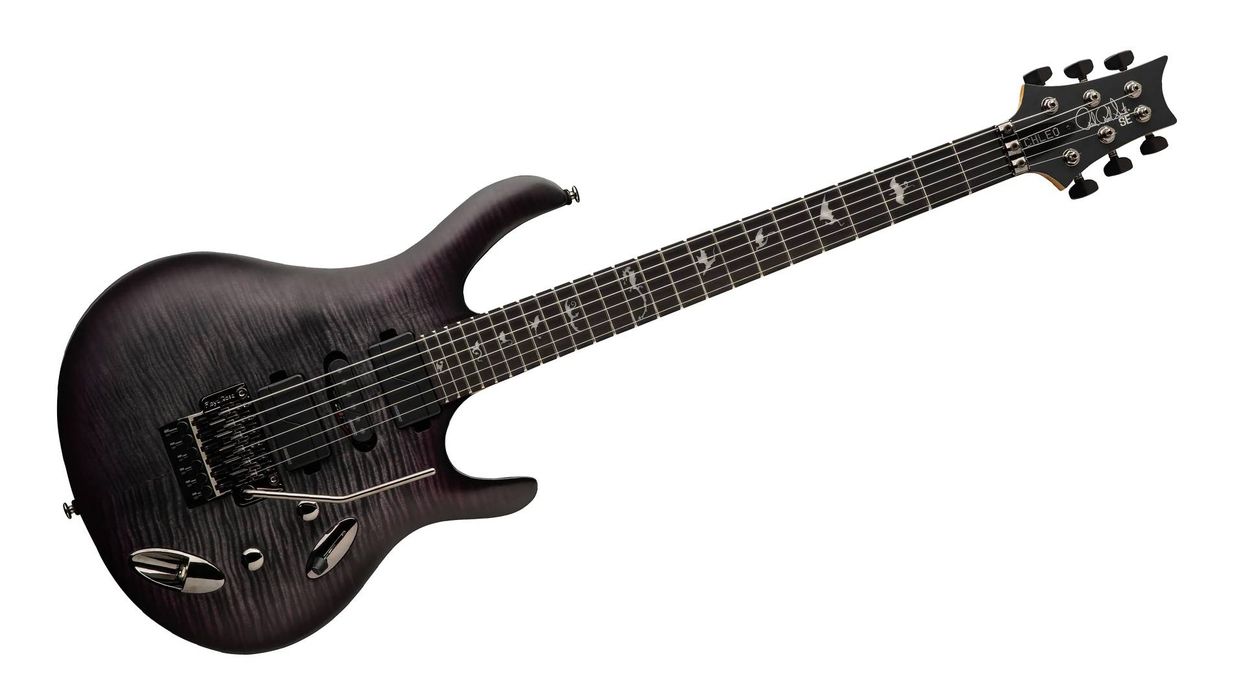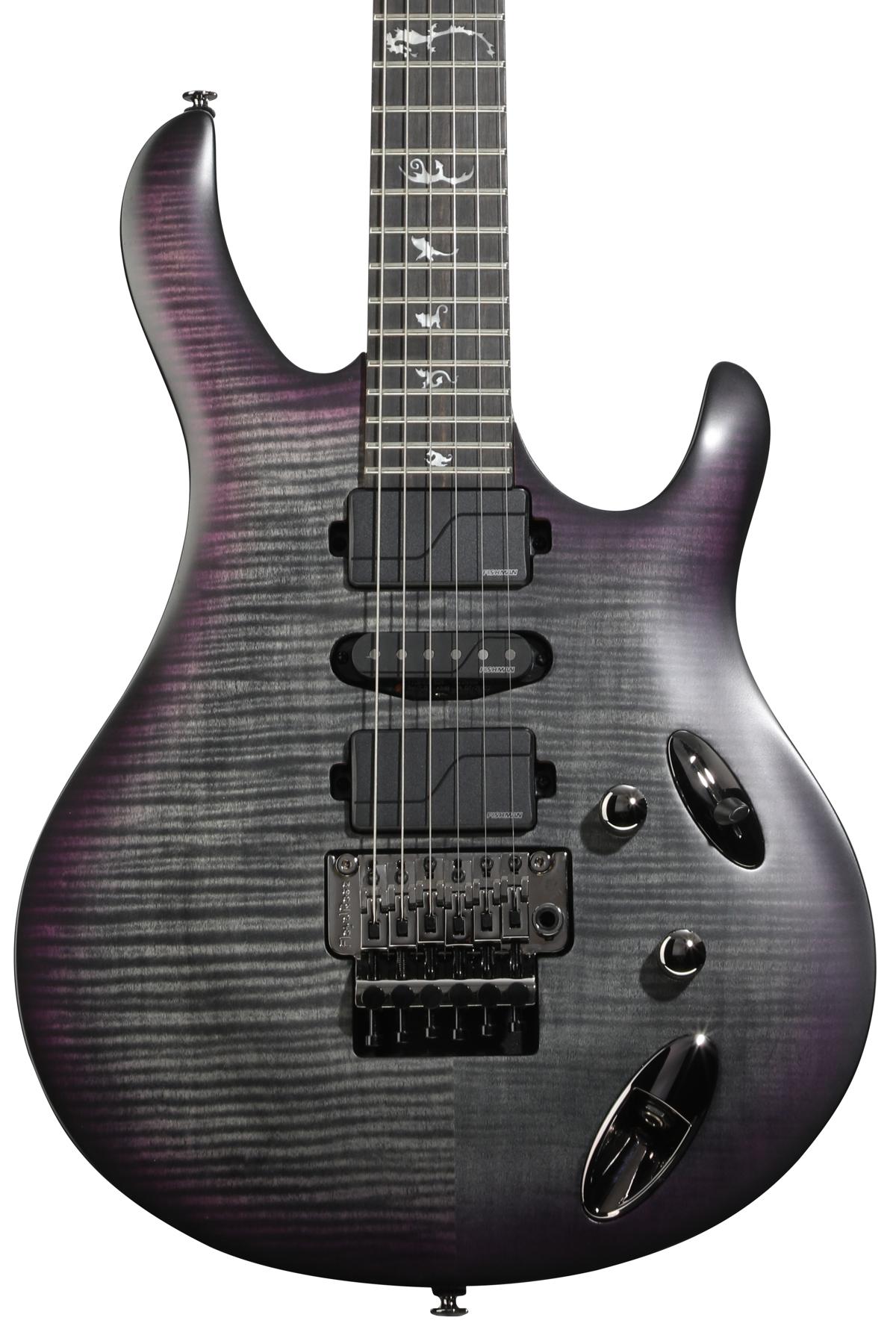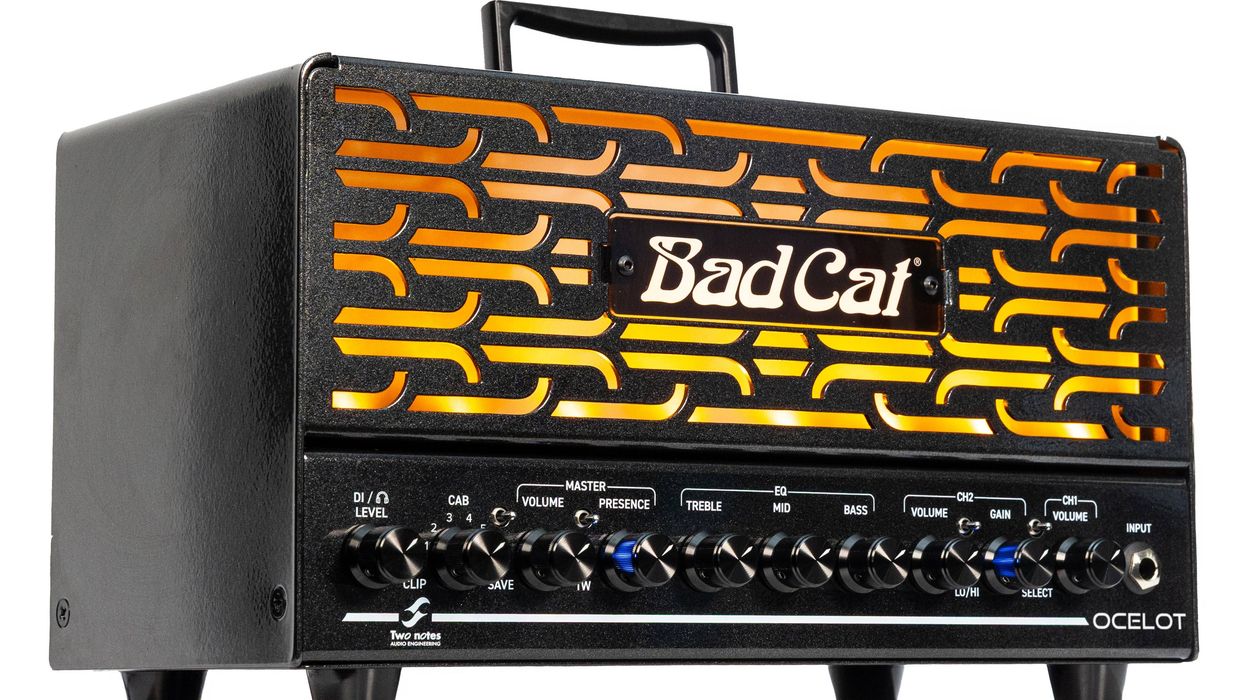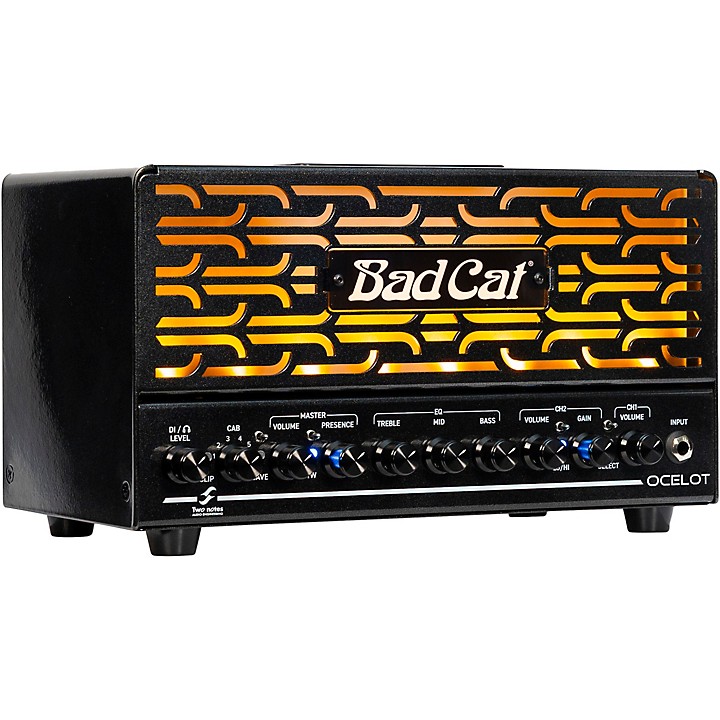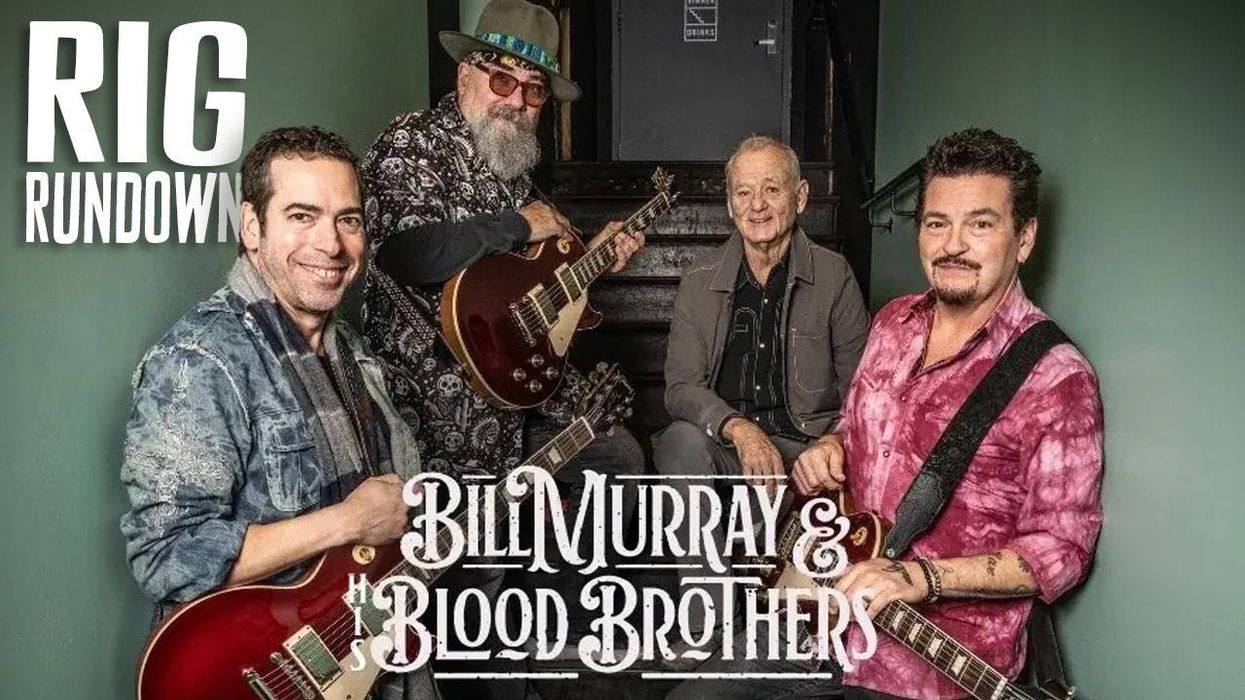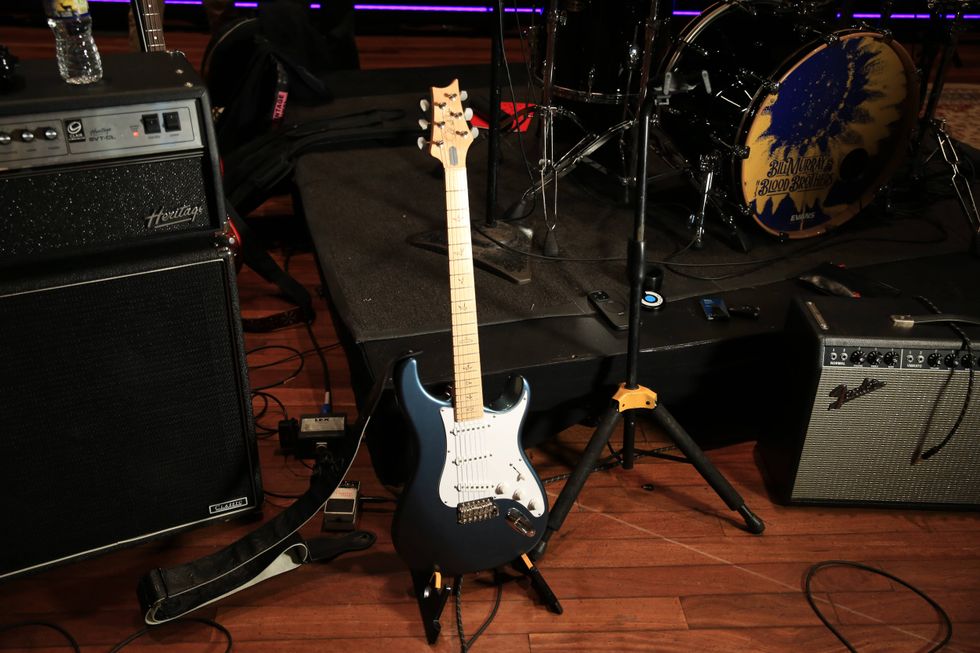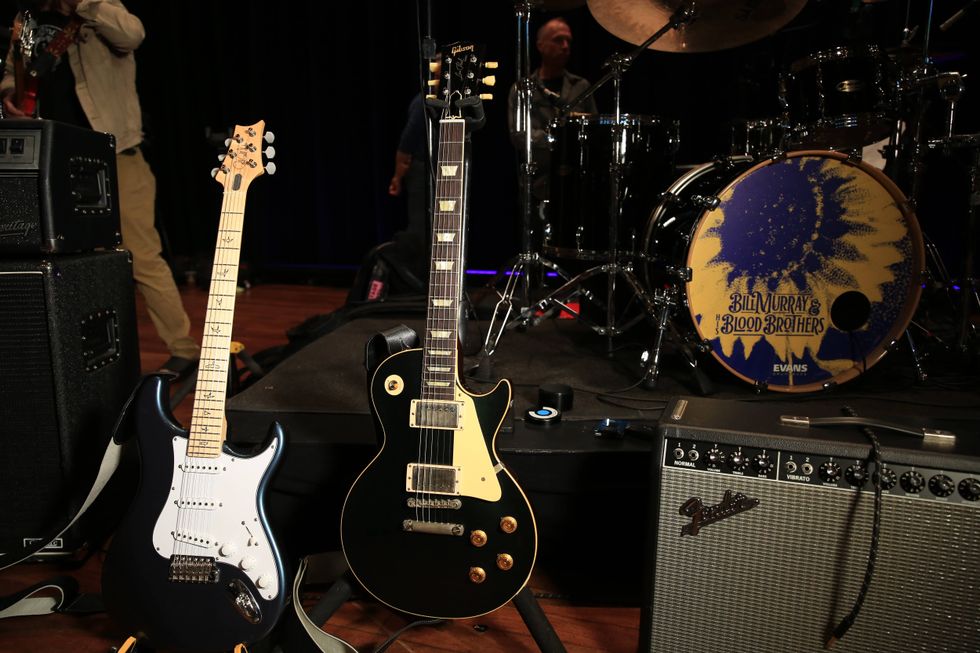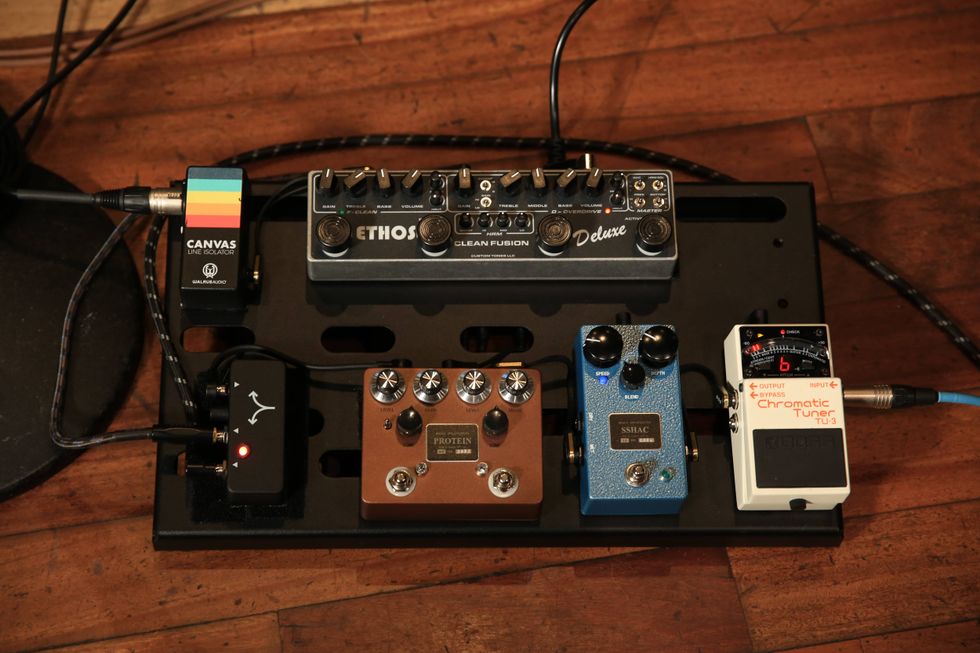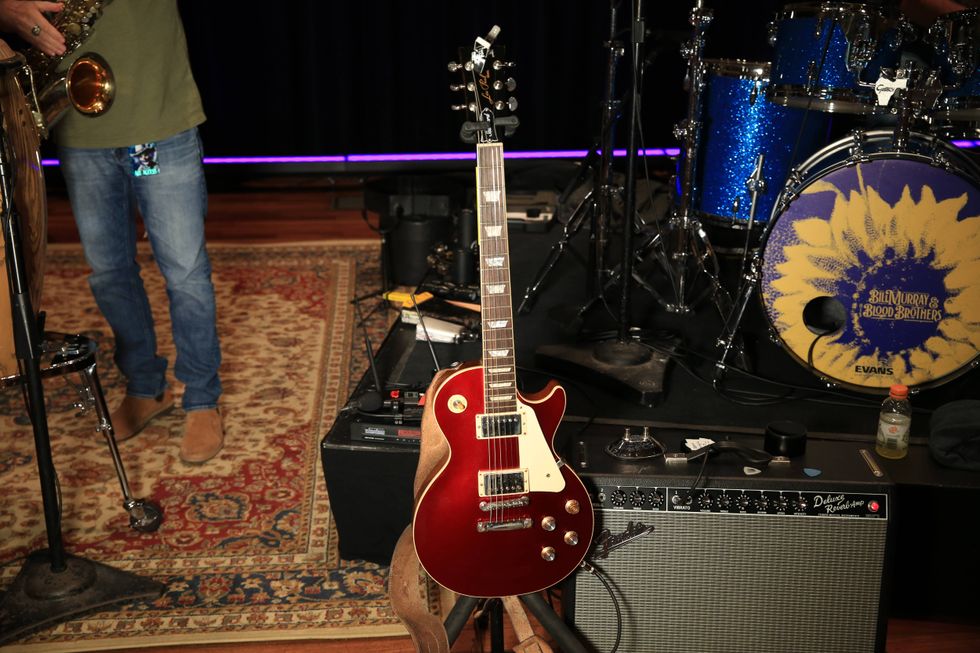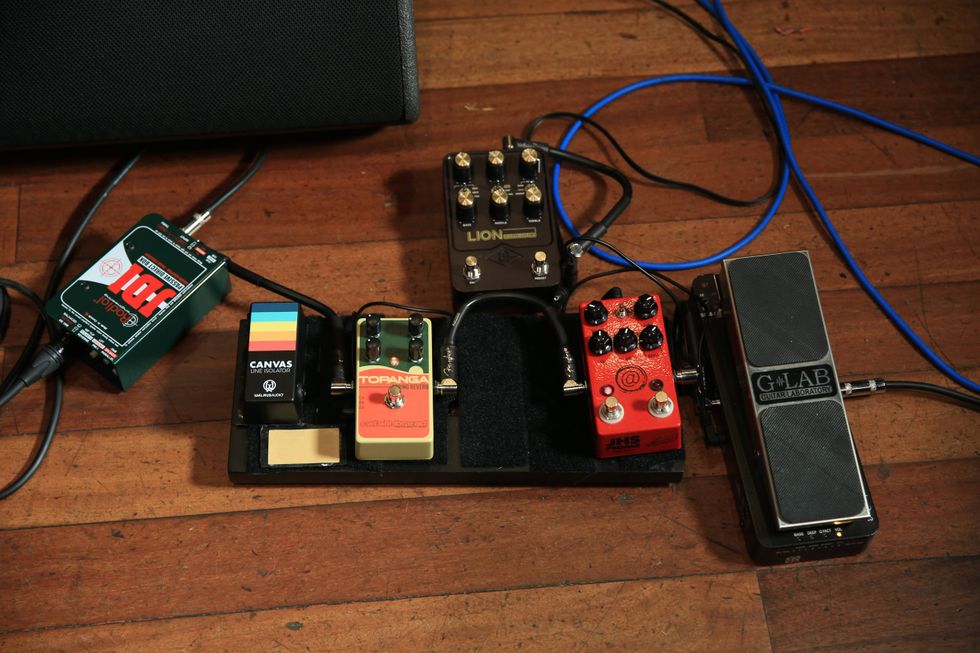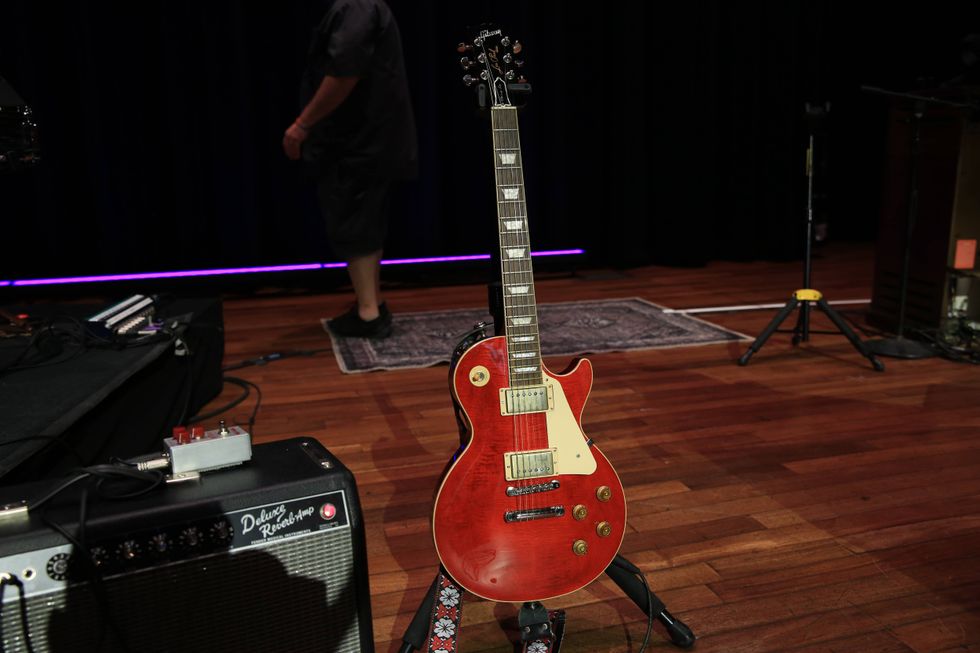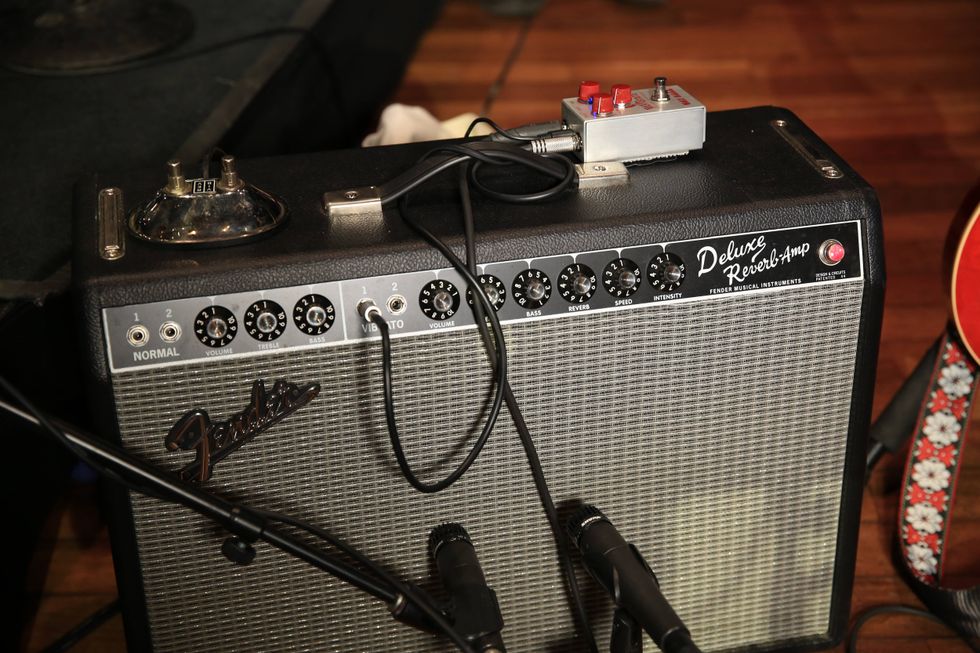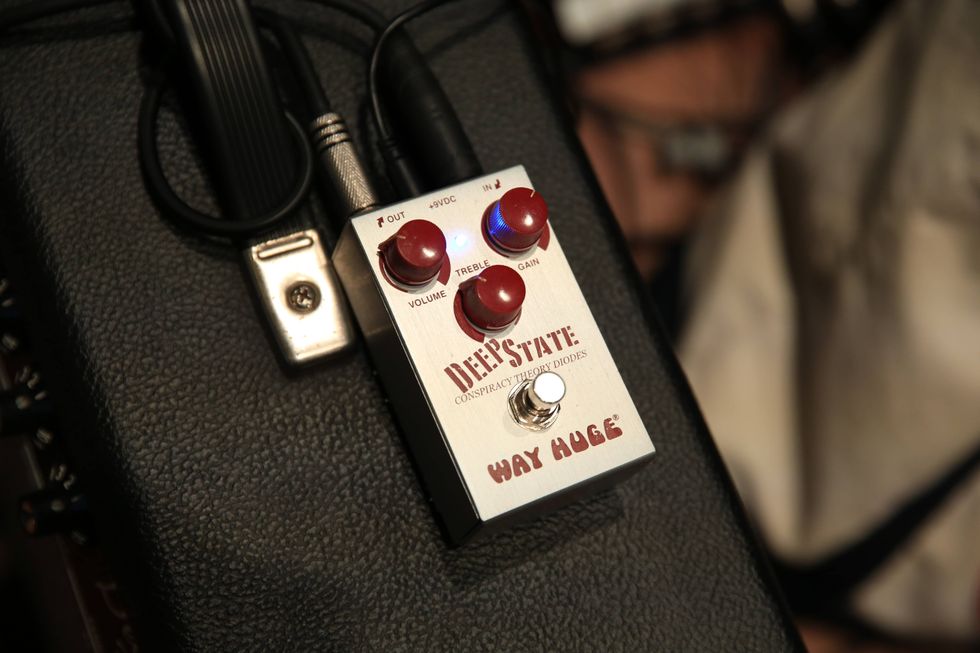There aren’t many individuals in the
modern amplifier industry that have
carved out the kind of legacy that James
Brown has. No, we’re not talking about
the late, great, gyrating, velvet suit-wearing
soul legend—we’re talking about the famed
amp designer that brought us the Peavey
VTM, Classic Series, Triple XXX, JSX, and
of course, the 5150. Brown’s work has had a
significant impact on the face of contemporary
rock. And his amp designs have been
instrumental in the evolution of the tones
of Joe Satriani and Eddie Van Halen.
Brown has since gone into business for himself with the Amptweaker pedal line, which has been a hit with the underground rock and metal crowd, as well as a new generation of blues and classic rock guitarists. His new pedal, dubbed the TightMetal, tends toward the thrashier side of the sound rainbow. But it’s a versatile tool too, with a smorgasbord of vicious distortion options and a smooth, natural-sounding noise gate that expands its usefulness.
The Devil in the Details
The TightMetal addresses the concern that most metal pedals only offer a caricature of the tone of bigger, metal-oriented amps without any of the feel and reactivity that makes those amps a more direct connection between players’ hands and the music.
Brown’s concern for real-world performance situations is evident in many of the pedal’s player-centric features. The rollbar keeps knobs and settings secure on hectic stages, the simple, yet effective magnetic battery drawer couldn’t be any more convenient, and a dedicated LED illuminates each knob when the pedal is used with a power supply. The pedal can also be powered by either a 9- or 18-volt power supply, with the latter causing the tone to open and clean up more, and react more like a 100-watt amplifier with a sharper, more immediate attack.
The pedal features true-bypass switching, and once you’ve switched the effect on, it’s controlled via four main knobs—Gain, Tone, Volume, and Tight. The latter is a powerful voicing control for morphing the tone from loose to tighter and chunkier.
One of the TightMetal’s primary missions is to maximize the impact of quick palm-muted riffs without sacrificing harmonic content. Just in front of the knobs, you’ll find two slide switches that are critical to achieving that objective. The first of these, the Mid slider, emphasizes the midrange when you move it to the left. But move the slider to the right or Thrash direction and the low end is boosted while the mids are scooped. The noise gate meanwhile, is activated when the pedal’s Gate switch is moved to the right, or Chomp setting. Combining the most aggressive settings for each control delivers nothing short of thrash heaven.
The TightMetal also features Amptweaker’s standard series effects loop, which can be set for either Pre or Post to position the TightMetal in the effects chain. Some really neat tones can be coaxed out of the pedal using this feature. You can place a compressor in the loop and set the loop to Pre to smooth things out even further. You can also use delays and reverbs with the loop set to Post to craft huge, spaced-out, post-rock soundscapes.
Evil Tendencies
This is one fierce-sounding little box, with more gain on tap than just about any pedal I’ve encountered. Thankfully, it stays solid and tight—as intended—when combined with the right amplifier, and a sense for how to mute and pick with focused precision.

Pedals with high-gain, thrashy-metal tendencies tend to work best with big-sounding and bassier clean amps. So I chose a 1976 Marshall Superbass head coupled with an Emperor 4x12 with Weber C1265 speakers for a 1978 Gibson Les Paul Custom—which is just about a perfect match for the TightMetal’s blistering onslaught.
Even with the Gate off, the pedal was tight in the low end, which worked great for some Slayer-inspired, palm-muted riffs. The Tone control, meanwhile, has a huge range, but I had to keep it below the 12 o’clock position to ensure that the treble didn’t become completely overpowering. Of course, if death by high end is your thing, the TightMetal has more than enough cut in the treble frequencies to do the job. But most players will get by with the Tone knob set anywhere below 1 o’clock.
The amount of distortion that can be dialed with the TightMetal should probably be measured in tons. With the Gain control at 10 o’clock, there was enough distortion to handle ’80s glam metal and bluesier hard rock. And as I brought up the gain, the sound got spongier in the mids, taking me into grungier and eventually, doomier territory. This is where the Tight control is most effective—enabling me to square off the rounded ends of the tone and transform it from a wide wall of devilish sound to a focused punch in the jaw.
Kicking in the gate only made the TightMetal angrier. And I tip my hat to Amptweaker for developing and implementing one of the most natural-sounding gates I’ve ever heard in a pedal. As I played with varying amounts of attack, the gate closed quickly on the end of each note but without any of the unnatural decay or ragged edges that are typically a byproduct of aggressive gating.
The Verdict
If you’re a metalhead in the market for a pedal that handles tight-fisted metal riffage, it’s hard to top the TightMetal. There’s more than enough gain for the most savage metal and a noise gate that reins in the background noise that goes with extreme distortion and enables extremely percussive palm muting and stops.
If you play with a brighter-sounding amp and guitar, you’ll need to keep your treble in check and tweak the pedal’s Tone control to make sure that the top end doesn’t take your head off. But if you long for tones from just a little south of heaven, the TightMetal just might be the chalice that can quench your thirst.
Watch the video review:
Brown has since gone into business for himself with the Amptweaker pedal line, which has been a hit with the underground rock and metal crowd, as well as a new generation of blues and classic rock guitarists. His new pedal, dubbed the TightMetal, tends toward the thrashier side of the sound rainbow. But it’s a versatile tool too, with a smorgasbord of vicious distortion options and a smooth, natural-sounding noise gate that expands its usefulness.
The Devil in the Details
The TightMetal addresses the concern that most metal pedals only offer a caricature of the tone of bigger, metal-oriented amps without any of the feel and reactivity that makes those amps a more direct connection between players’ hands and the music.
Brown’s concern for real-world performance situations is evident in many of the pedal’s player-centric features. The rollbar keeps knobs and settings secure on hectic stages, the simple, yet effective magnetic battery drawer couldn’t be any more convenient, and a dedicated LED illuminates each knob when the pedal is used with a power supply. The pedal can also be powered by either a 9- or 18-volt power supply, with the latter causing the tone to open and clean up more, and react more like a 100-watt amplifier with a sharper, more immediate attack.
The pedal features true-bypass switching, and once you’ve switched the effect on, it’s controlled via four main knobs—Gain, Tone, Volume, and Tight. The latter is a powerful voicing control for morphing the tone from loose to tighter and chunkier.
One of the TightMetal’s primary missions is to maximize the impact of quick palm-muted riffs without sacrificing harmonic content. Just in front of the knobs, you’ll find two slide switches that are critical to achieving that objective. The first of these, the Mid slider, emphasizes the midrange when you move it to the left. But move the slider to the right or Thrash direction and the low end is boosted while the mids are scooped. The noise gate meanwhile, is activated when the pedal’s Gate switch is moved to the right, or Chomp setting. Combining the most aggressive settings for each control delivers nothing short of thrash heaven.
The TightMetal also features Amptweaker’s standard series effects loop, which can be set for either Pre or Post to position the TightMetal in the effects chain. Some really neat tones can be coaxed out of the pedal using this feature. You can place a compressor in the loop and set the loop to Pre to smooth things out even further. You can also use delays and reverbs with the loop set to Post to craft huge, spaced-out, post-rock soundscapes.
Evil Tendencies
This is one fierce-sounding little box, with more gain on tap than just about any pedal I’ve encountered. Thankfully, it stays solid and tight—as intended—when combined with the right amplifier, and a sense for how to mute and pick with focused precision.
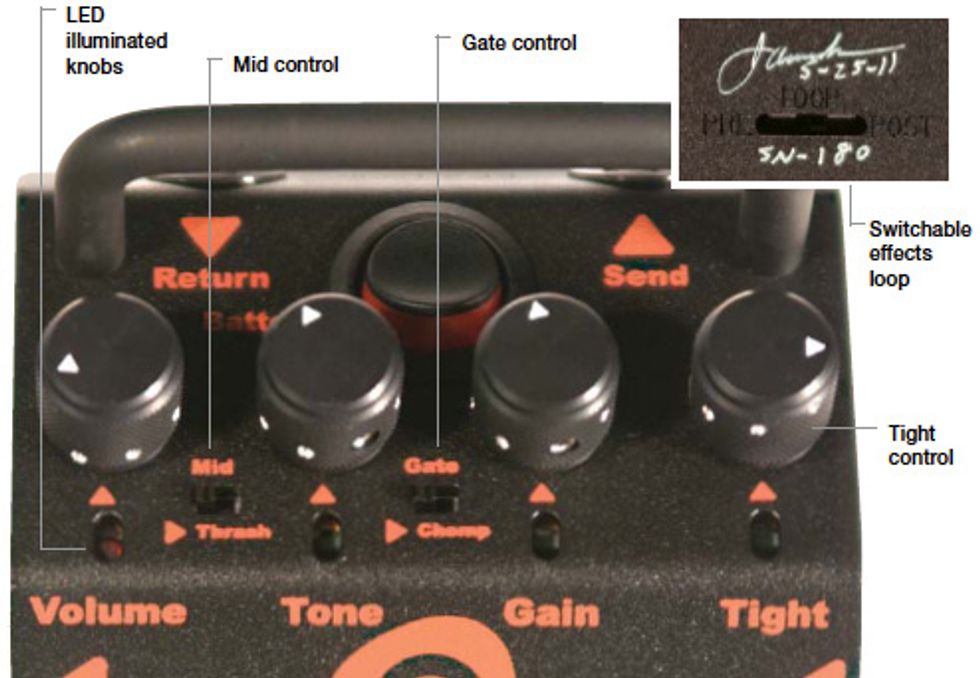
Pedals with high-gain, thrashy-metal tendencies tend to work best with big-sounding and bassier clean amps. So I chose a 1976 Marshall Superbass head coupled with an Emperor 4x12 with Weber C1265 speakers for a 1978 Gibson Les Paul Custom—which is just about a perfect match for the TightMetal’s blistering onslaught.
Even with the Gate off, the pedal was tight in the low end, which worked great for some Slayer-inspired, palm-muted riffs. The Tone control, meanwhile, has a huge range, but I had to keep it below the 12 o’clock position to ensure that the treble didn’t become completely overpowering. Of course, if death by high end is your thing, the TightMetal has more than enough cut in the treble frequencies to do the job. But most players will get by with the Tone knob set anywhere below 1 o’clock.
The amount of distortion that can be dialed with the TightMetal should probably be measured in tons. With the Gain control at 10 o’clock, there was enough distortion to handle ’80s glam metal and bluesier hard rock. And as I brought up the gain, the sound got spongier in the mids, taking me into grungier and eventually, doomier territory. This is where the Tight control is most effective—enabling me to square off the rounded ends of the tone and transform it from a wide wall of devilish sound to a focused punch in the jaw.
Kicking in the gate only made the TightMetal angrier. And I tip my hat to Amptweaker for developing and implementing one of the most natural-sounding gates I’ve ever heard in a pedal. As I played with varying amounts of attack, the gate closed quickly on the end of each note but without any of the unnatural decay or ragged edges that are typically a byproduct of aggressive gating.
The Verdict
If you’re a metalhead in the market for a pedal that handles tight-fisted metal riffage, it’s hard to top the TightMetal. There’s more than enough gain for the most savage metal and a noise gate that reins in the background noise that goes with extreme distortion and enables extremely percussive palm muting and stops.
If you play with a brighter-sounding amp and guitar, you’ll need to keep your treble in check and tweak the pedal’s Tone control to make sure that the top end doesn’t take your head off. But if you long for tones from just a little south of heaven, the TightMetal just might be the chalice that can quench your thirst.
Watch the video review:
Buy if...
you’re an insatiable thrash fiend in need of supremely tight and gated distortion.
Skip if...
the battle-din of metal isn’t your calling.
Rating...
Street $180 direct - Amptweaker - amptweaker.com |


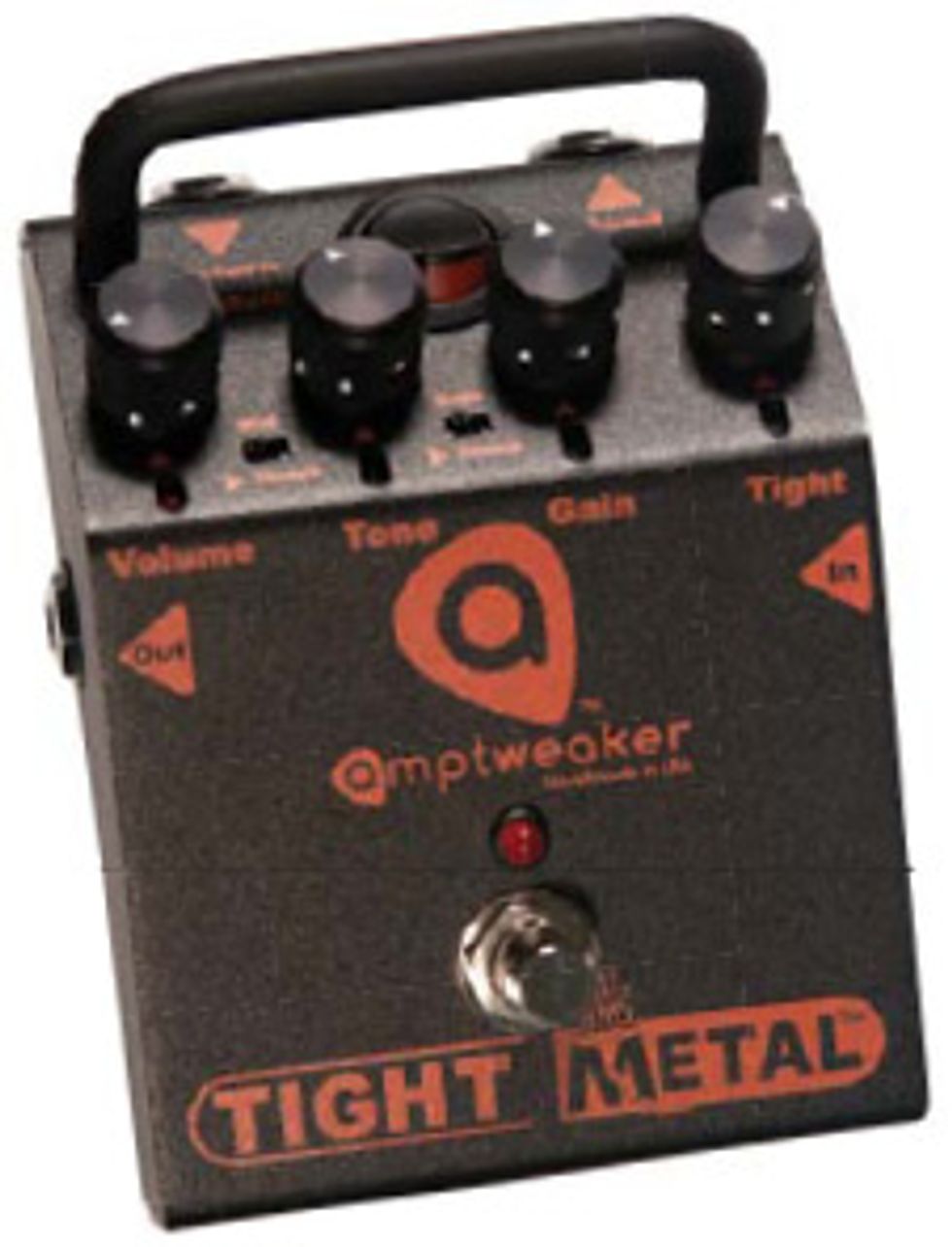

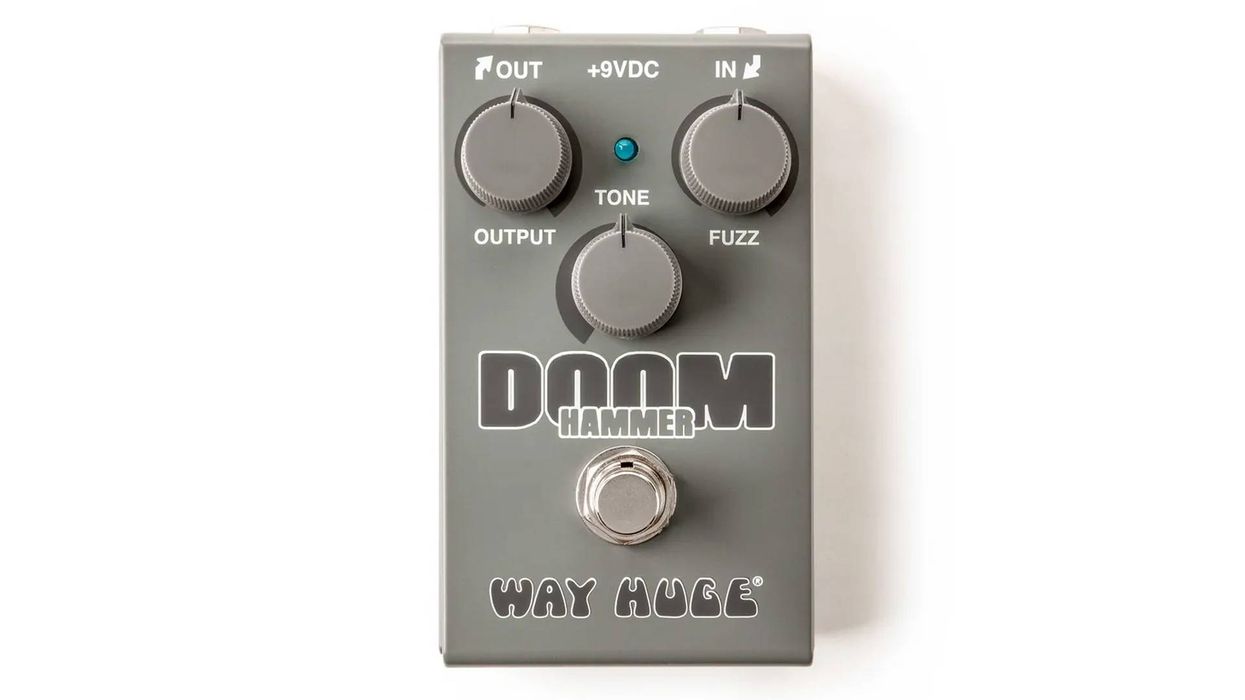
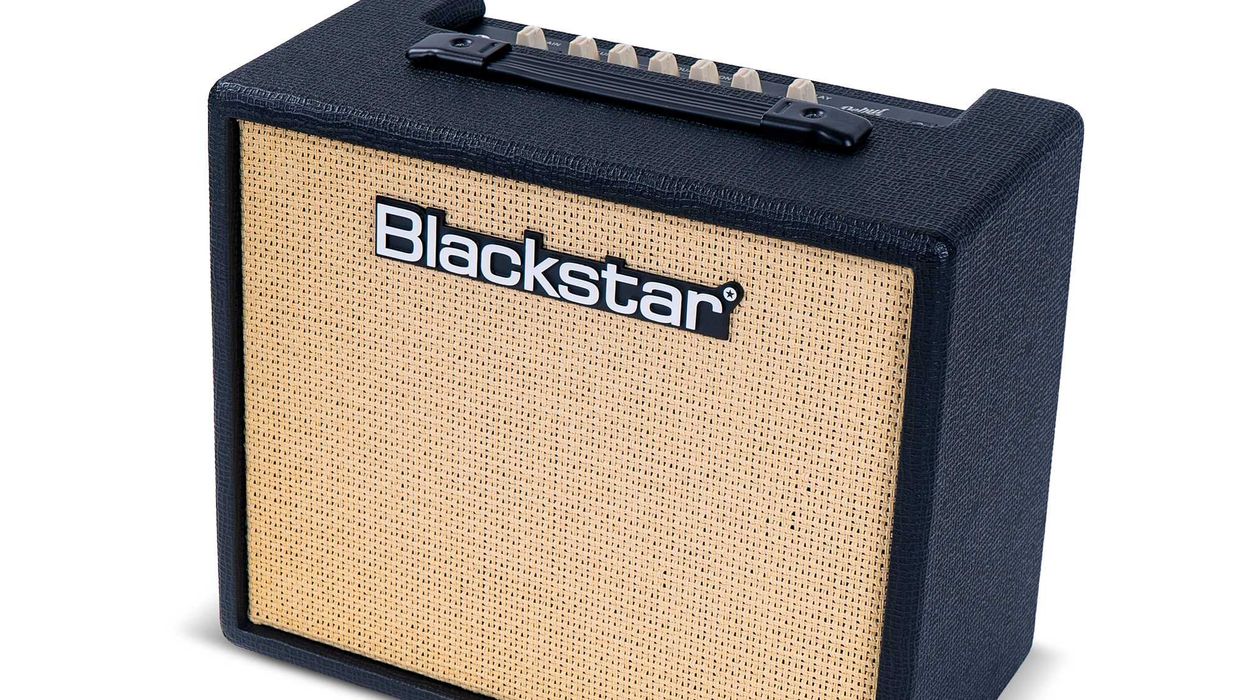
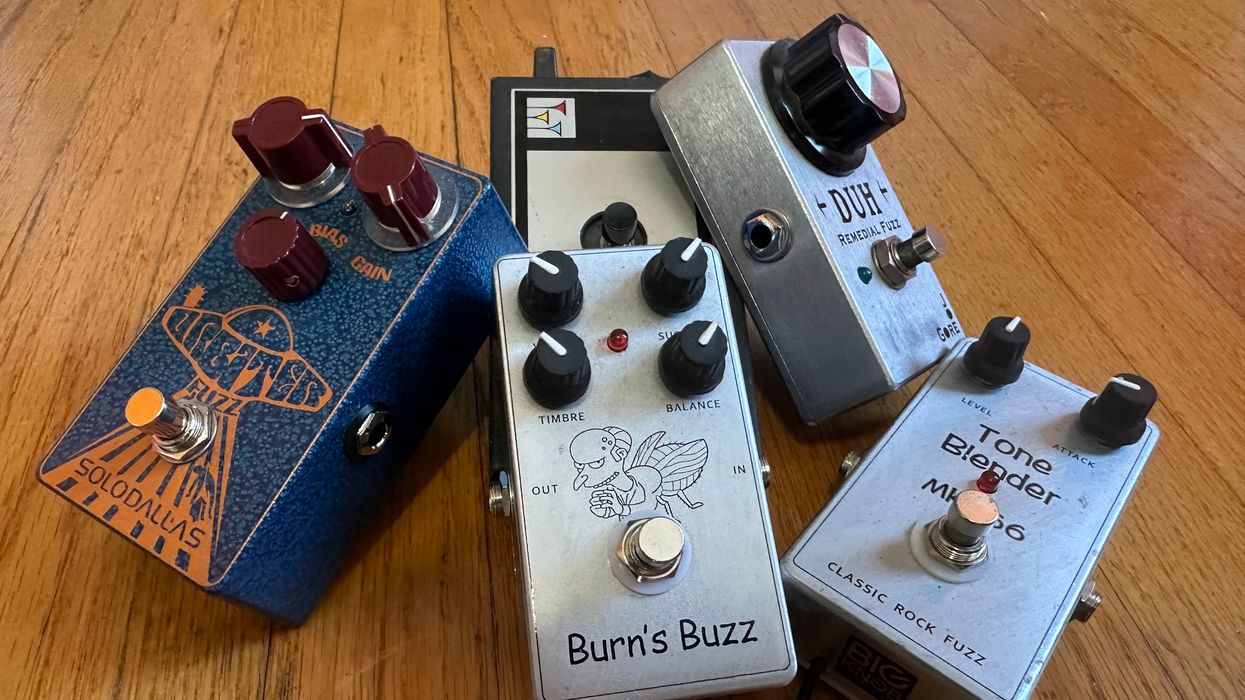

![Rig Rundown: Russian Circles’ Mike Sullivan [2025]](https://www.premierguitar.com/media-library/youtube.jpg?id=62303631&width=1245&height=700&quality=70&coordinates=0%2C0%2C0%2C0)
